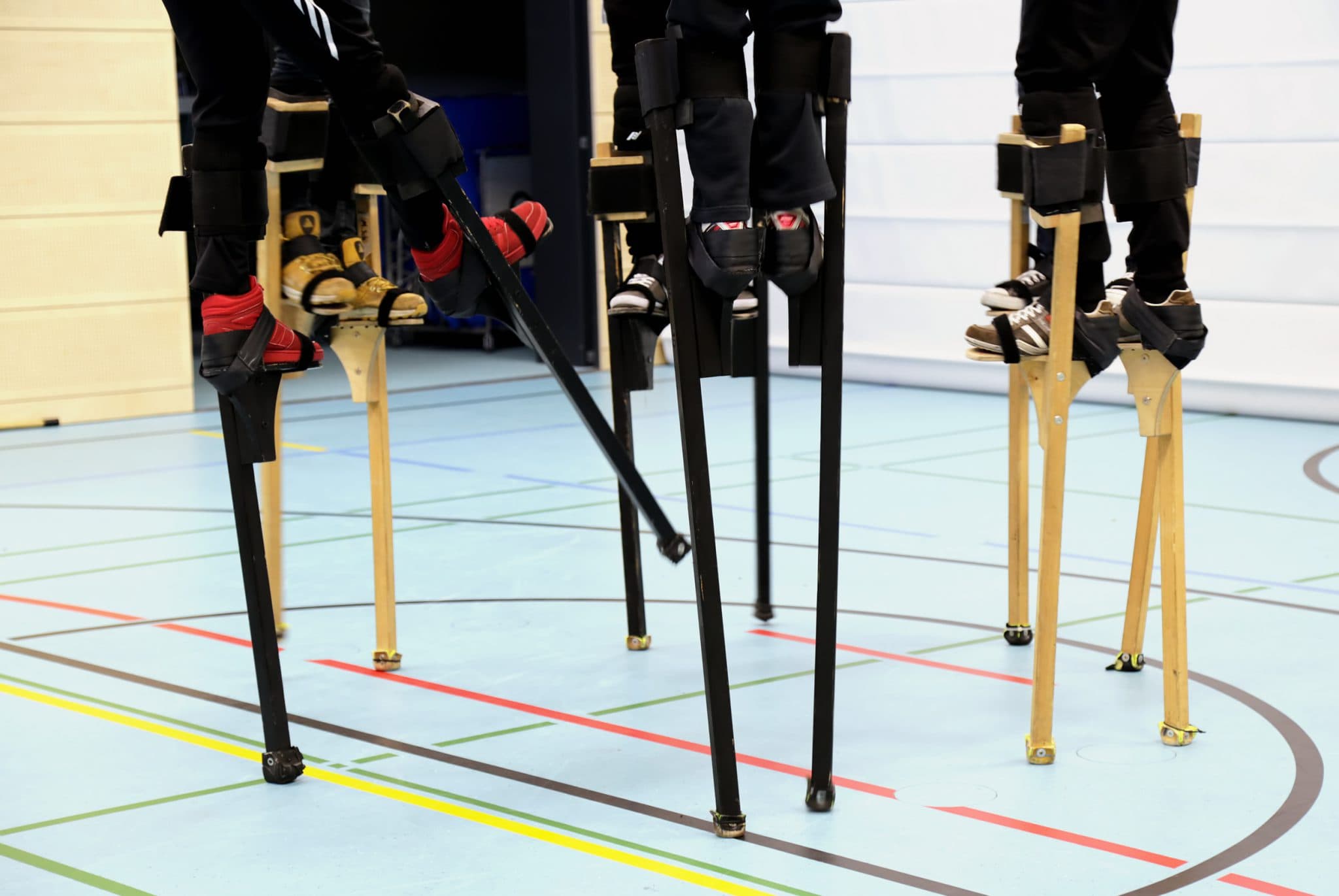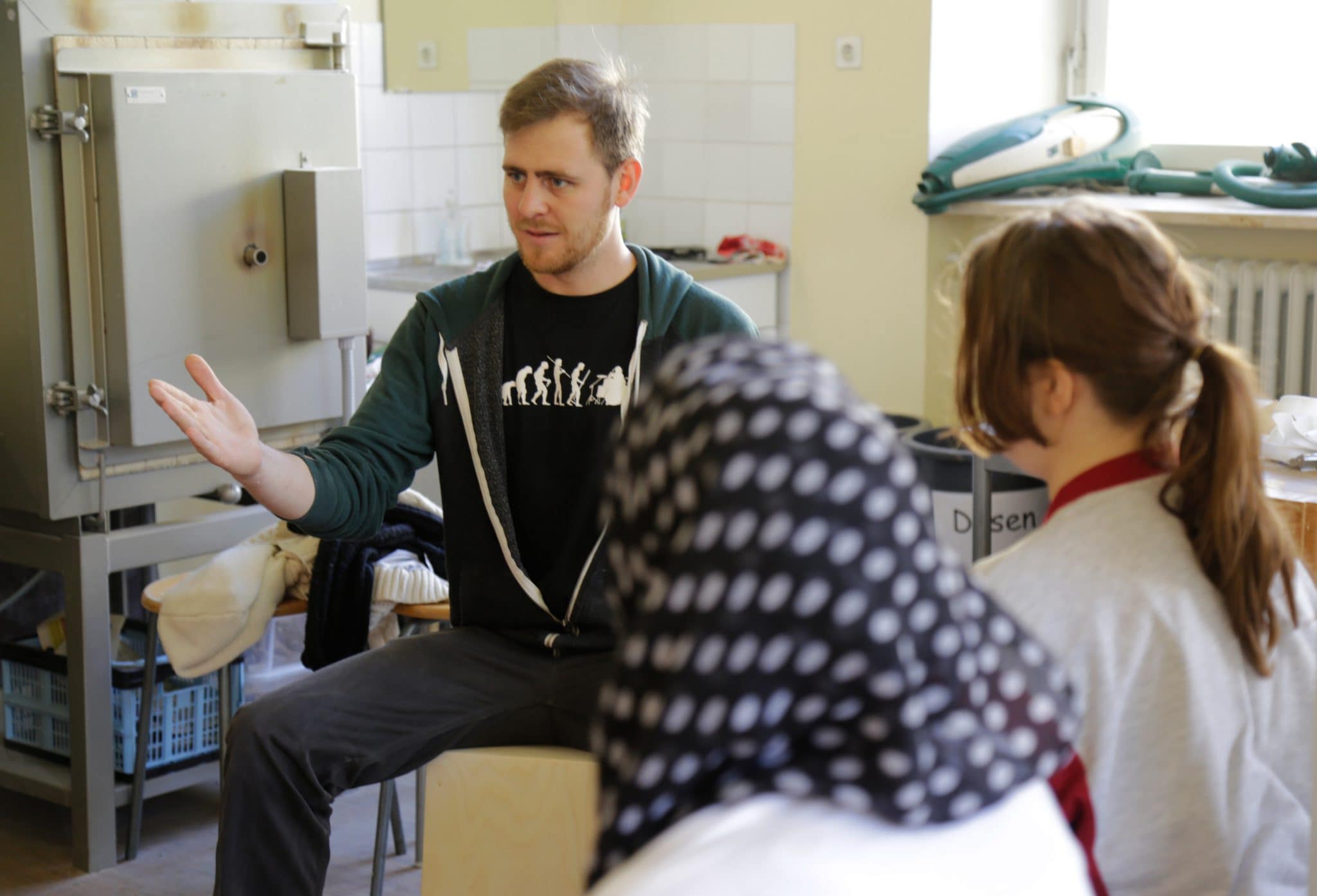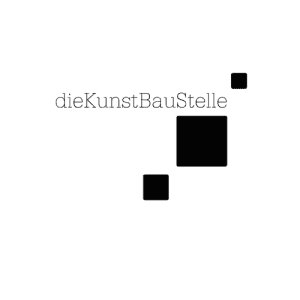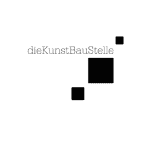from Andrea Schmelzle
In cultural refugee and youth work, the Landsberg cultural association “dieKunstBauStelle e.V.” teaches cultural mediation techniques on a national and international level in cooperation with the theater “Die Stelzer”.
Landsberg am Lech, 27 June 2016: The Landsberg cultural association “dieKunstBauStelle e.V.” is increasingly bundling its know-how and expertise in the field of cultural youth work as an organizational body and is active at national and international level with the teaching of cultural techniques. The principle of training trainers in order to achieve a multiplier effect is always at the forefront: local trainers are trained as multipliers under professional guidance, who in turn train further trainers and provide children with cultural activities.
The format was developed by the director of “Die Stelzer” theater, Wolfgang Hauck, and has been implemented in Turkey together with members of the ensemble since 2014. The work with stilts forms the basis, which is combined with other activities such as costume construction, music or circus techniques as “social circus”. Working with stilts in particular has proven to be an excellent means of trauma education.
It all started in Landsberg am Lech with stilt courses. Back in 2008, “Die Stelzer” gained experience working abroad with street children in Morocco. This was followed by courses at schools and, as part of the open-air theater “Licca Line”, the development of a youth group over more than four years. The model of the stilts, which was originally constructed with the Landsberg vocational school for the play “Licca Line”, is now in use all over the world – in Austria, Northern Ireland, Italy, Iraq and Turkey.

Culture as a perspective: international work in Turkey
Since 2014, “Die Stelzer” have been working with refugees in Turkey as part of their “Cultural Relief Program”. In part directly on the Turkish-Syrian border in refugee camps and in the city of Mardin. The activities have now been extended to Istanbul. As around 250,000 refugees live in the Turkish metropolis alone, the model project is being transferred there in order to multiply the effect. This involves working with aid organizations that offer a wide range of refugee support services in Turkey, such as the “Foundation for the Refugee Education Trust – RET” – in Kiziltepe, or the “Red Crescent” in Istanbul. The Goethe-Institut Istanbul is involved as an organizer and sponsor, and the NGO “Her Yerde Sanat Derneği” from Mardin acts as a local partner to the respective refugee camps and the Turkish administration. This cooperation enables “Die Stelzer” to offer and carry out the relevant training courses.
The often traumatized young refugees not only need basic humanitarian care, but also perspectives and rays of hope in their everyday lives full of hardship. “The longer the refugees stay in one place – and this also applies to the situation here – the greater the need for culture and education,” explains Wolfgang Hauck, initiator of the Cultural Relief Program. “Culture, theater, dance and music are becoming immensely important for young people. On the one hand, to improve their life situation, and on the other, to prepare and support their independent participation in life.”

“Simple stilts or hammer handles as percussion instruments are enough to make a difference here,” continues Hauck. “It’s an important experience for the children that, despite everything they’ve been through, they can get back to an everyday life where there is something like fun, joy and friends.”
Just a few days ago, he returned from a nine-day stay in Istanbul. He was once again supported by Landsberg residents Leonard Mandl from the Stelzer ensemble and Anselm Kirsch (percussion teacher). The reason for the trip this time was World Refugee Day on June 20, 2016 – and the team was in great demand:
“In Esenler – a district in Istanbul with 500,000 inhabitants – we offered our workshops on the children’s street in collaboration with the Insan Kaynaklari Gelistirme Vakfi foundation,” reports Hauck. “One day later, we were in Bakirköy – at the Hipodrom. Here, aid organizations and 500 children were invited to take part in various courses in cooperation with Project Lift. The next day, we finally went to Kücükcekmece, another district of Istanbul, for a stilt and circus workshop for educators from the Red Crescent social institution.
The Federal Foreign Office brings “Die Stelzer” to Berlin
Due to the international experience gained from cultural work with young refugees in Turkey, the Stelzer’s work is now also being requested at federal level. “In Berlin, we have presented our Cultural Relief Program twice to members of the Bundestag and experts from various committees,” reports Hauck. For example, at the “Moving People” forum in April this year: the entire spectrum of Germany’s foreign cultural and educational policy was presented over three days.
In August, they will be going to Berlin again for a presentation on the occasion of the Federal Foreign Office’s Open Day. “Workshops lasting several hours will be held in which young people from Iraq will work for us as trainers,” says Hauck. And they are good acquaintances of the Stelzer family, as they are the very young people who were once trained in the refugee camps in Turkey. “They have now fled to Germany, live in Berlin and support us as trainers,” says Hauck happily.
Funding from the Free State of Bavaria
The cultural projects of the dieKunstBauStelle association and the Stelzer are also in demand and recognized throughout Bavaria:
In Glonn, dieKunstBauStelle, together with the Stelzer and in cooperation with the Schloss Zinneberg youth welfare facility, runs an extracurricular educational measure to promote the linguistic and cultural integration of unaccompanied refugee minors together with German schoolchildren. “By combining physical and artistic activities, it is possible to provide special support in listening comprehension and speaking,” emphasizes Hauck. “Education and language acquisition is the first step towards successful integration into society.”

This educational project “KIDZ Zinneberg” also convinced the Ministry and is now receiving funding from the 2016 Cultural Fund of the Free State of Bavaria so that it can be continued alongside schools in the 2016-2017 school year.
“Back to the roots”: focus back on Landsberg and the surrounding area
Thanks to the success of projects such as “KIDZ Zinneberg” and film reports by the German Foreign Office, among others, more and more organizations and institutions have contacted Hauck to become active with similar models: In the Landsberg district, for example, a cooperation with “Sternenwünsche”, a project of the Rotary Club Ammersee-Römerstraße for children and young people aged five to 17, is now in preparation. A special cultural program for young people could be held as early as the coming summer vacations. A project week is planned with youth welfare facilities in the Landsberg district and the Ammersee region.
“It is important to us to support associations or projects where we can see that the money is actually felt and is not just ‘sand in the gears’,” says Silvie Braun, one of the “Sternenwünsche” ambassadors, explaining the motivation for supporting the KunstBauStelle. “We really appreciate the association and think it’s great how it brings very different cultures and people together with its projects. Much more needs to be done for children and young people in particular, because after all, children are the future – our future.”
And that applies to people all over the world, whether they come from Syria, Iraq, Turkey, Berlin or Landsberg.
Last week, Wolfgang Hauck handed over urgently needed relief supplies – baby clothes and diapers – worth 2,200 euros to the logistics manager of the Nusaybin refugee camp on behalf of the Landsberg cultural association “dieKunstBauStelle e.V.”. The “Netzwerk Selbsthilfe e.V.” association donated this sum to dieKunstBauStelle for the refugee camp. Further donations were made by the “Netzwerk Selbsthilfe” and the “Rotary Sozialfonds Greifenberg-Schondorfe.V.” for the “Cultural Relief Program” of the “Die Stelzer” theater.
In Nusaybin in south-eastern Turkey, just five kilometers from the Syrian border, the “Die Stelzer” theater is running a cultural aid programme. Wolfgang Hauck developed the concept during his first visit in December 2014. It is based on a multiplier effect: Trainers are trained as multipliers under professional guidance, who in turn train other trainers and provide children with cultural activities.
“When I saw the scale of the” smallest “camp in Nusaybin a year ago, with 3,975 refugees, half of whom were children and young people, it was clear that we had to act on a different scale,” says the initiator, who was commissioned by the Goethe-Institut Istanbul as an expert for cultural projects and invited to implement a cultural aid program. “If you then look at the camps in Urfa and Jordan with 20,000 or 120,000 refugees, such a concept is unavoidable.”
The children and young people are also traumatized due to experiences of violence and flight. “We are now specifically in a refugee camp for Yezidis, who not only come from civil war-torn Syria but also from Iraq. These people are not only fleeing war and IS, but are also persecuted as a religious minority. Their everyday lives are not only full of hardship, but also without any prospects or prospects.”
The need is great
Basic supplies are provided in these camps, but that only means food, water and a place to pitch a tent. Everything else is a luxury. The young mothers with their newborn babies are hit the hardest. They lack the most basic hygiene products. To date, around 350 children have been born in the camp. This year alone, 92 newborns have been born.
“For this reason, I have tried to provide small but direct humanitarian aid in addition to cultural aid. I was able to collect donations for this and have now used 2,200 euros,” says Hauck. With the help of the NGO “Her Yerde Sanat Derneği”, they bought 270 first aid kits for newborns and 270 large packs of diapers.
Tense situation
The original plan was to combine the handover of the equipment with further training at the camp. Landsberg-based Leonhard Mandl, stilt trainer, and Anselm Kirsch, music and percussion teacher, were part of the team for this purpose. However, things turned out differently: an absolute curfew was imposed on the city of Nusaybin (approx. 140,000 inhabitants). Seven civilians were shot dead during this phase. “The situation is extremely tense and critical. There have been several civilian deaths,” reports the head of the project. “We only received permission from the governor to go into the camp on the last day before we left for Germany. We were only able to stay there for an hour to hand over the donation.”
“Even if it’s only small amounts of aid: We can see that it arrives and where it arrives,” says Hauck. “In addition, our small amount of aid also serves to build trust with the camp administration and the governor, which is immensely important for our further cultural and social work there.”
During the handover, there was at least a brief opportunity to meet the young people with whom we have often worked together. They were about to present a demonstration for the younger children. It was immediately clear that the concept of “training the trainers” works. The young people organize themselves, make their own costumes, think up productions, in short: they do something.
Support from four “circus heroes”
A further donation of 4,000 euros will therefore be used to support four youth trainers. The four circus heroes of the NGO “Art Anywhere Association” of a “Social Circus School” in Mardin are 14-year-old Ahmet, 12-year-old Hale, 14-year-old Eyad and 13-year-old Khalid. They have already been trained by Wolfgang Hauck and other trainers so that they can now teach other children. These funds will give them the opportunity to attend a regular school and continue their education. This is by no means the norm for these refugee children: they would otherwise have to work six days a week, ten hours a day, for four euros a day to support their families, who have no opportunity to work or earn money.
This important cultural aid, which is also significant from a trauma education perspective, is now being extended to Iraq. A trainer from the program is already active there and has founded a first group in the refugee camp in Khanke (20,000 refugees). He was provided with stilts, drums and equipment by the Goethe-Institut Istanbul. Young people are also being trained here. “However, our aim is also to use our cultural work to provide humanitarian aid – as far as this is possible within our framework,” emphasizes Hauck.
The experience gained from the projects is also used in Germany. A follow-up project is a cooperation with the school in Schloß Zinneberg, where unaccompanied refugee minors are taught German in an integrative way. Hauck has also given presentations on the situation in Iraq, Syria and Turkey as well as an overview of the possibilities for cultural activities.
The more you get to know the problems in the Arab world, the more difficult it is to answer questions about solutions. It is precisely this insight that politicians need in order to deal realistically with the refugee problem here and to plan. Unfortunately, there is still a lack of information and approaches are too short-term.
The need is still great, whether for relief supplies or for the continuation of cultural work: anyone wishing to donate directly can easily do so online:
Donation link: Humanitarian Aid Nusaybin
Donation link: Cultural Relief Program
Info about the program
www. CulturalRelief.org

